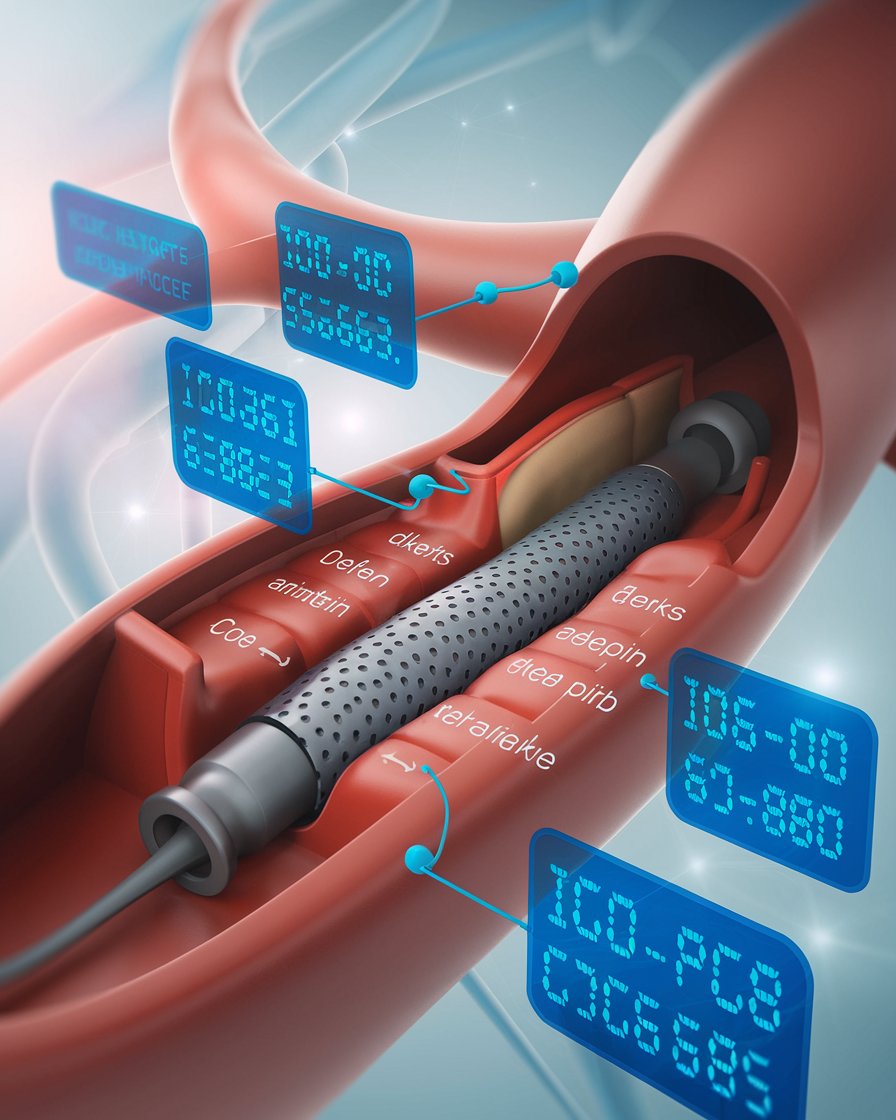Introduction
Intraluminal devices, such as drug-eluting stents, play a critical role in modern medical procedures, particularly in vascular surgeries. These devices are used to maintain or restore the patency of arteries and veins, ensuring proper blood flow. The ICD-10-PCS classification system helps codify these procedures, offering healthcare professionals a reliable way to document medical interventions involving intraluminal devices. Accurate classification is crucial as it affects billing, patient records, and treatment outcomes. By understanding the specific codes for each device, medical providers can ensure that every procedure is properly documented.
ICD-10-PCS provides a comprehensive table of codes that encompass various methods of intraluminal device placement, such as percutaneous or endoscopic approaches. The system extends to cover a range of devices, including those left in place or grafts used in vascular repair. This classification is updated frequently to stay current with advancements in medical technology, helping professionals locate the appropriate code for every procedure, ensuring precision in the medical industry.
Key Takeaways
-
Intraluminal devices, like drug-eluting stents, are crucial for maintaining blood flow in vascular surgeries.
-
ICD-10-PCS offers a comprehensive coding system for documenting procedures involving intraluminal devices.
-
The percutaneous approach, widely used for device placement, ensures minimally invasive access for maintaining vessel patency.
-
Accurate ICD-10-PCS classification of devices, including stents, ensures proper medical documentation and billing.
-
Annual updates to ICD-10-PCS codes help professionals stay aligned with advances in device technology and medical practices.
-
Medical professionals rely on ICD-10-PCS to classify procedures precisely, improving patient outcomes and operational efficiency.
Understanding the Function of an Intraluminal Device in the ICD-10-PCS Classification
An intraluminal device is a vital medical tool often used in procedures like stenting or artery occlusion. Within the ICD-10-PCS classification system, understanding the function of such a device is essential for correct code assignment. This classification system provides healthcare professionals a standardized way to document procedures, especially those involving vascular branches. By inserting a device, often through a percutaneous approach, it ensures the affected part of a vessel remains open or blocked as needed. Medical professionals rely on accurate documentation and the specific code value associated with each device to ensure proper billing and treatment continuity.
Key Insights on Intraluminal Devices in ICD-10-PCS Code Lookup
-
Critical Role of Intraluminal Devices in Vascular Procedures
Intraluminal devices, such as drug-eluting stents, are vital in maintaining or restoring the patency of arteries, which is crucial in treating conditions like stenosis or occlusion. -
Importance of ICD-10-PCS Classification in Medical Coding
The ICD-10-PCS system offers a detailed, standardized classification for medical procedures, helping professionals document operations accurately, especially those involving vascular devices. -
Percutaneous Approach for Minimally Invasive Device Placement
A percutaneous approach is frequently used to insert intraluminal devices with minimal disruption to the patient’s body, leading to faster recovery times and better outcomes. -
Annual Updates in ICD-10-PCS for Technological Advancements
The ICD-10-PCS system is regularly updated to reflect innovations in medical technology, ensuring accurate coding for procedures involving advanced devices like bioactive stents. -
Impact of Accurate Coding on Medical Outcomes and Billing
Proper coding of intraluminal devices within ICD-10-PCS not only aids in efficient billing but also ensures compliance with medical regulations, ultimately improving patient care. -
The Role of Device Types in Determining ICD-10-PCS Codes
Different types of intraluminal devices, such as balloon catheters and drug-eluting stents, require specific codes in the ICD-10-PCS system, reflecting the method and approach used in the procedure.
Percutaneous Approach to Intraluminal Device Placement
The percutaneous approach is a common method for placing intraluminal devices, such as stents, within arteries or veins. In the ICD-10-PCS system, this approach involves the insertion of a device through the skin, providing a minimally invasive option for patients. The classification system outlines this procedure with specific codes that relate to the device’s insertion point, type, and the vascular branch affected. This method ensures that the device can maintain vessel patency or occlude specific portions of a vessel to manage conditions like blockages or aneurysms effectively.
Role of Intraluminal Devices in Maintaining Vascular Patency
Intraluminal devices, particularly drug-eluting stents, are essential for maintaining the openness, or patency, of arteries and veins. These devices release medication that prevents restenosis or re-narrowing of the vessel. ICD-10-PCS codes for these procedures specify the type of device, its placement, and how it relates to the affected part of the vascular system. Accurate coding of these devices ensures proper classification, improving patient outcomes and supporting correct billing practices in medical institutions.
How ICD-10-PCS Codes Relate to Specific Medical Procedures Involving Devices
ICD-10-PCS codes serve as a detailed reference for medical professionals, helping them codify specific procedures involving devices. For example, a drug-eluting stent placed within an artery is a procedure that needs precise code classification to reflect the nature of the operation. Whether a device is inserted into a vascular branch or used to occlude a portion of a vessel, understanding how these codes relate to specific medical actions is crucial. Each code reflects not only the type of device but also the approach taken during the procedure, such as percutaneous or endoscopic, ensuring accurate medical records and treatment plans.
Case Study: Accurate ICD-10-PCS Classification in Drug-Eluting Stent Placement
A major healthcare provider performed a complex vascular procedure involving the placement of a drug-eluting stent to treat a patient with severe arterial narrowing. The hospital relied on the ICD-10-PCS system to classify the procedure accurately. By using the correct code, which documented the stent’s type, the percutaneous approach, and the affected vascular branch, the medical team ensured complete and accurate records. The hospital saw improvements in billing efficiency and a reduction in coding errors, ultimately enhancing patient care and regulatory compliance. This case highlights the importance of precise classification and how it benefits both healthcare providers and patients through improved documentation and streamlined administrative processes.
Classifying Drug-Eluting Stents in ICD-10-PCS
Drug-eluting stents are one of the most commonly used devices in vascular procedures, especially for patients with narrowed arteries. In ICD-10-PCS, the classification of these stents includes details like the material, size, and placement method. Understanding how these codes relate to procedures is crucial for medical professionals to ensure that the operation is documented accurately. By consulting the code lookup, professionals can reference the most up-to-date classification list, which helps codify the procedure in line with Centers for Medicare and Medicaid guidelines.
Endoscopic Approaches to Intraluminal Device Placement
Endoscopic procedures, where devices are placed using a flexible scope, provide a different approach compared to percutaneous methods. ICD-10-PCS codes cover these procedures, ensuring that the approach, device type, and vessel branch involved are clearly defined. This allows for specific classification, which aids in treatment planning and patient record management. The use of endoscopic approaches can reduce recovery time and risk, making it a valuable option in modern vascular surgery.
The Value of Accurate Classification: Defining Parts of an Intraluminal Device in ICD-10-PCS
In the ICD-10-PCS system, the value of accurate classification is paramount, especially when defining the parts and purposes of an intraluminal device. Medical professionals must carefully identify which portion of the vascular system is involved, whether it’s a superficial femoral artery or a more complex body part. Devices, including drug-eluting stents, may vary in size and material, such as metal or bioactive substances. Accurate classification ensures that each procedure is correctly documented and that the appropriate value is applied within the system, aiding in medical accuracy and patient care.
Defining Stent Parts for Precise ICD-10-PCS Classification
Stents can have various parts, such as the tubular structure that keeps the artery open and the drug-eluting surface. Accurate classification of these parts within the ICD-10-PCS is essential for ensuring precise medical documentation. By defining each part and its function, healthcare professionals can better codify procedures involving stent placement. This classification provides clarity on the type of stent used, its specific application in the vascular system, and how it interacts with the body’s anatomy, which is critical for both patient care and medical billing.
The Role of Vascular Branches in Device Classification
In ICD-10-PCS, the classification of intraluminal devices also depends on the specific vascular branch involved, such as the superficial femoral artery or another significant body part. Each branch plays a role in how the device is placed, what method is used, and how the procedure is codified. Accurate identification of the branch ensures that the correct procedure is recorded in the medical classification system, enhancing the precision of treatment records and ensuring compliance with coding regulations.
“Precision is everything in medicine—it’s not just about getting it right but about making sure that every detail, every decision, is accounted for.” – Dr. Atul Gawande
Exploring the Branches of ICD-10-PCS: A Deep Dive into Device Classifications
ICD-10-PCS branches into various classifications, particularly when it comes to devices used in medical procedures. Each device classification, such as a balloon catheter for dilation or a bioactive stent, plays a unique role in treating vascular conditions. These classifications relate to how devices are applied to maintain patency in arteries or other body parts. Medical professionals must consult the ICD-10-PCS code lookup regularly, as each year brings updates that refine the accuracy of device classifications. Understanding these branches helps ensure that the device and method used in surgery are properly recorded and billed.
Medical Classification Lists by Centers for Medicare and Medicaid Services
The Centers for Medicare and Medicaid Services (CMS) release annual updates to the ICD-10-PCS classification system. These updates include detailed information on medical devices like stents, ensuring that healthcare providers have access to the latest data for accurate coding. The classifications help identify which procedures involve intraluminal devices, the parts of the body affected, and the approaches used. Following the updates helps maintain compliance with Medicare and Medicaid billing standards, ensuring accurate reimbursement for services provided.
Impact of ICD-10-PCS Code Updates on Medical Procedures
Each year, the ICD-10-PCS system is updated with new codes and classifications, which directly impact how medical procedures involving devices are recorded. For example, new classifications may be added for devices that are inserted into less common vascular branches or that involve advanced technology like bioactive stents. Staying informed about these updates ensures that medical professionals can accurately document procedures, apply the correct device classification, and maintain compliance with healthcare standards, improving patient care and operational efficiency.
[lasso rel=”amazon-50″ id=”2096″]
Conclusion
Intraluminal devices, such as drug-eluting stents, play a key role in maintaining the patency of arteries and veins, ensuring proper blood flow during vascular procedures. The ICD-10-PCS classification system helps medical professionals accurately document these procedures, using specific codes to reflect the method, device, and approach involved. By ensuring precise classification, healthcare providers can maintain the quality of medical records and ensure correct billing for services performed.
With frequent updates, the ICD-10-PCS system adapts to evolving medical technologies, ensuring that devices like intraluminal stents are codified accurately. The system also provides codes for various approaches, such as percutaneous and endoscopic methods, which allow for a minimally invasive experience. As medical professionals rely on this system to document procedures each year, it ensures compliance with industry standards and enhances patient care by allowing healthcare providers to perform procedures with a clear, codified structure in place.















